1993 CADILLAC FLEETWOOD steering
[x] Cancel search: steeringPage 195 of 386
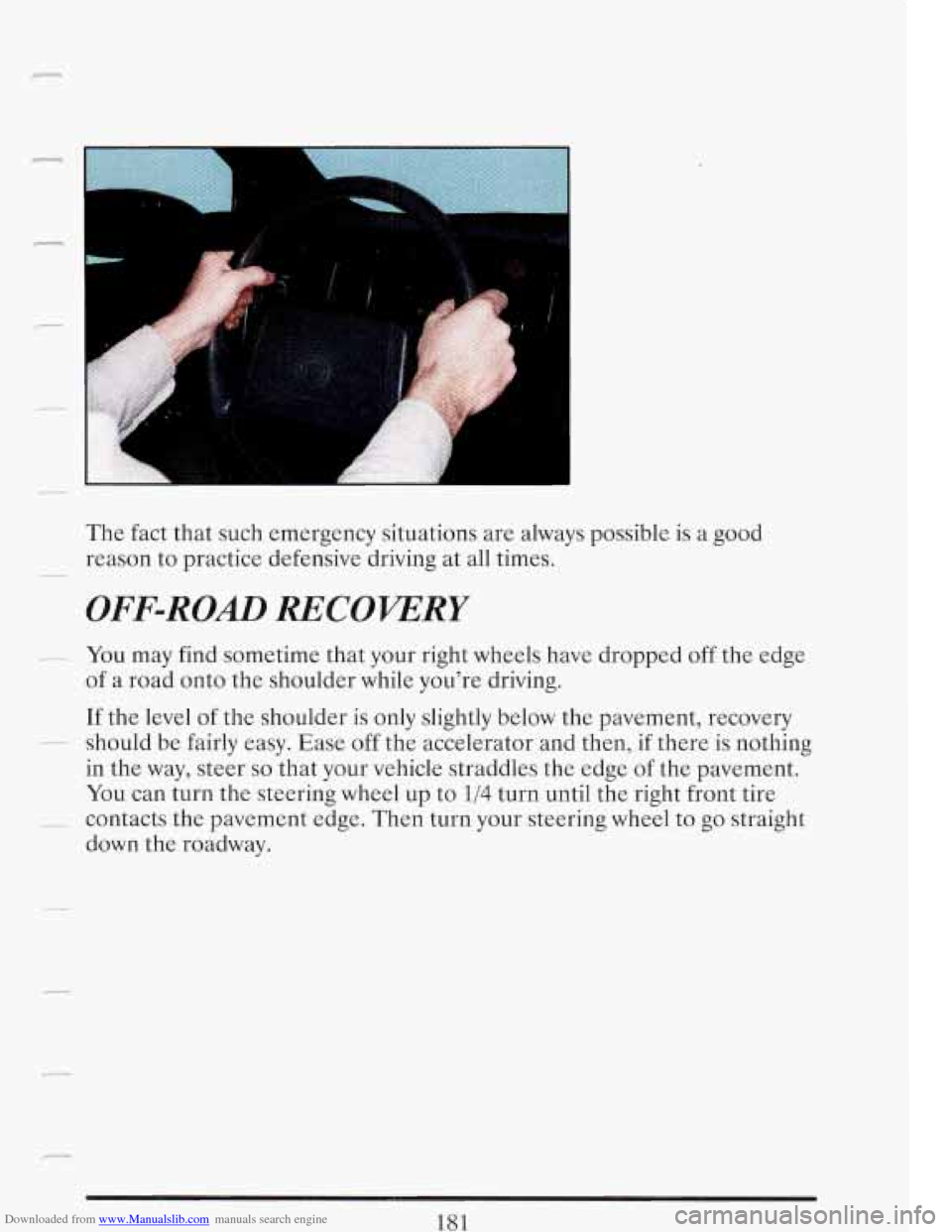
Downloaded from www.Manualslib.com manuals search engine c
7
The fact that such emergency situations are always possible is a good
reason to practice defensive driving at all times.
OFF-ROAD RECOVERY
You may find sometime that your right wheels have dropped off the edge
of a road onto the shoulder while you’re driving.
If the level of the shoulder is only slightly below the pavement, recovery
should be fairly easy. Ease
off the accelerator and then, if there is nothing
in the way, steer
so that your vehicle straddles the edge of the pavement.
You can turn the steering wheel up to
1/4 turn until the right front tire
contacts the pavement edge. Then turn
your steering wheel to go straight
down the roadway.
181
Page 196 of 386
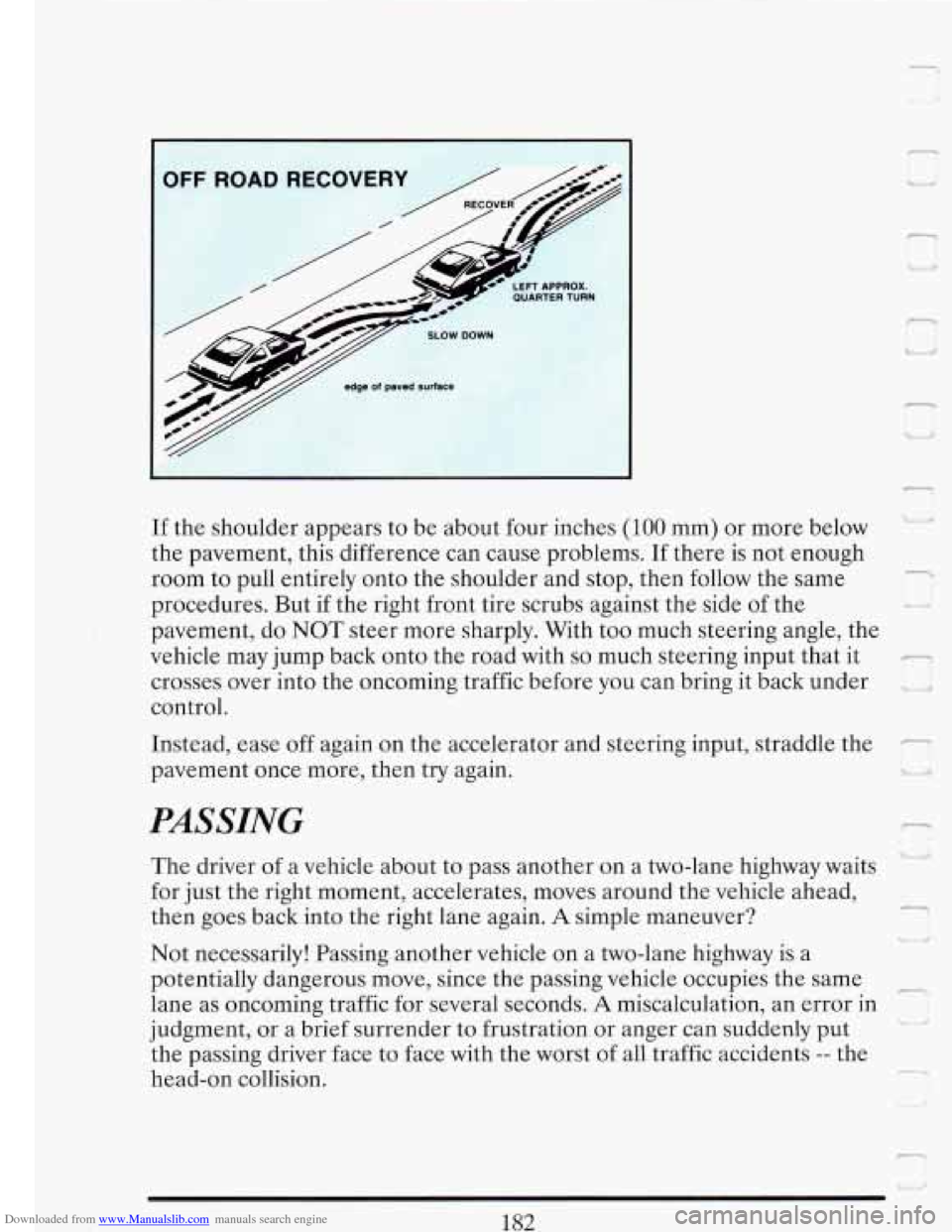
Downloaded from www.Manualslib.com manuals search engine -. I
SLOW DOWN
edge of paved suriace
I
n
u- 1
If the shoulder appears to be about four inches (100 mm) or more below
the pavement, this difference can cause problems.
If there is not enough
room to pull entirely onto the shoulder and stop, then follow the same
procedures. But if the right front tire scrubs against the side of the
-
pavement, do NOT steer more sharply. With too much steering angle, the
vehicle may jump back onto the road with
so much steering input that it *c'-
crosses over into the oncoming traffic before you can bring it back under .
control.
Instead, ease off again on the accelerator and steering input, straddle the
--
pavement once more, then try again.
PASSING c t
The driver of a vehicle about to pass another on a two-lane highway waits
for just the right moment, accelerates, moves around the vehicle ahead,
then goes back into the right lane again.
A simple maneuver? -.
Not necessarily! Passing another vehicle on a two-lane highway is a
potentially dangerous move, since the passing vehicle occupies the same
lane as oncoming traffic for several seconds.
A miscalculation, an error in
judgment, or a brief surrender to frustration or anger can suddenly put
the passing driver face to face with the worst of all traffic accidents
-- the
head-on collision.
-
182
Page 198 of 386
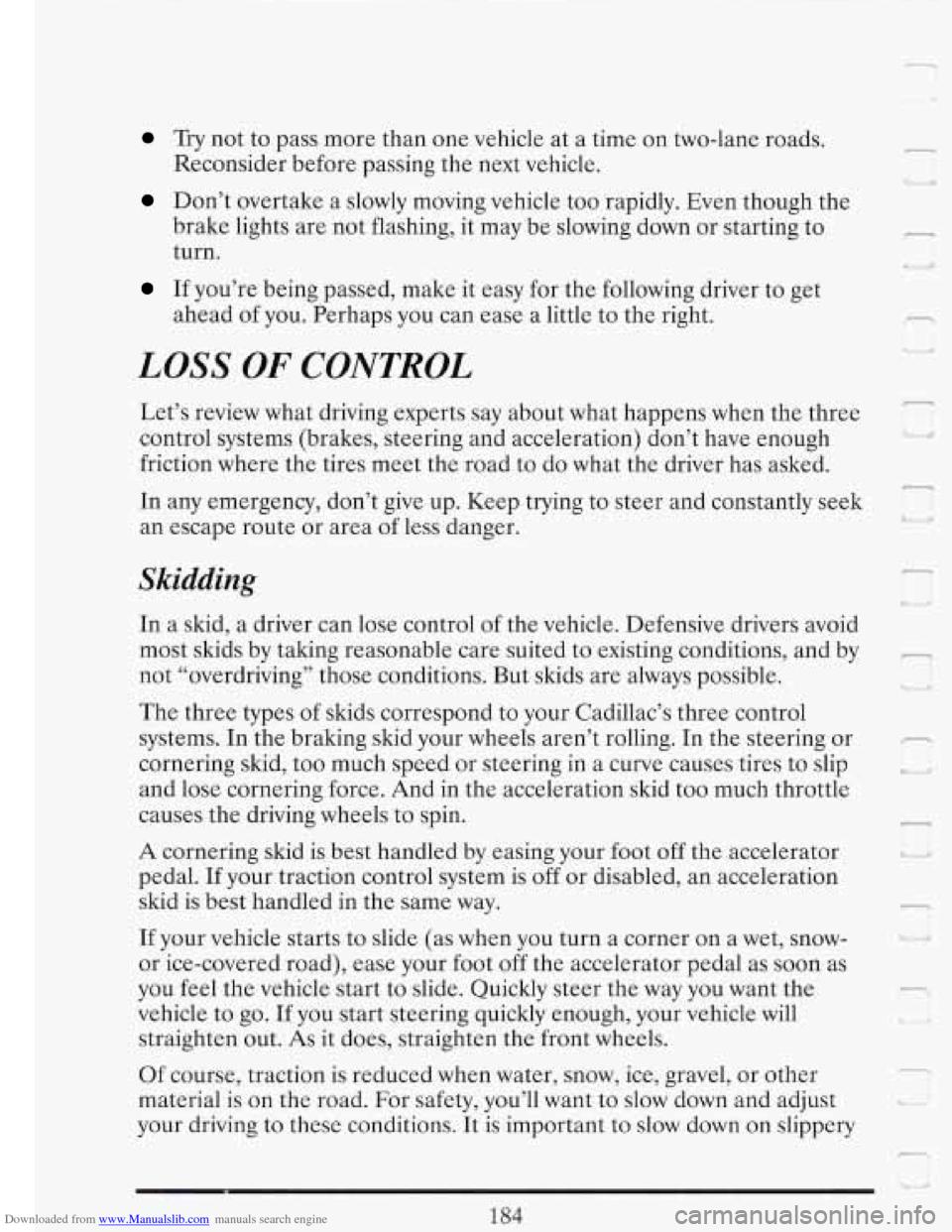
Downloaded from www.Manualslib.com manuals search engine Try not to pass more than one vehicle at a time on two-lane roads.
Reconsider before passing the next vehicle.
Don’t overtake a slowly moving vehicle too rapidly. Even though the
brake lights are
not flashing, it may be slowing down or starting to
turn.
If you’re being passed, make it easy for the following driver to get
ahead
of you. Perhaps you can ease a little to the right.
LOSS OF CONTROL
i
r
I/ U
Let’s review what driving experts say about what happens when the three
control systems (brakes, steering and acceleration) don’t have enough
’; I I
friction where the tires meet the road to do what the driver has asked.
r
In any emergency, don’t give up. Keep trying to steer and constantly seek
an escape route or area
of less danger.
-
le
Skidding
In a skid, a driver can lose control of the vehicle. Defensive drivers avoid
most skids by taking reasonable care suited to existing conditions, and by
._
not “overdriving” those conditions. But skids are always possible. < .,
The three types of skids correspond to your Cadillac’s three control
systems. In the braking skid your wheels aren’t rolling.
In the steering or
cornering skid, too much speed or steering in a curve causes tires to slip
and lose cornering force. And in the acceleration skid too much throttle
causes the driving wheels to spin.
A cornering skid is best handled by easing your foot off the accelerator
pedal.
If your traction control system is off or disabled, an acceleration
skid is best handled in the same way.
If your vehicle starts to slide (as when you turn a corner on a wet, snow-
or ice-covered road), ease your foot off the accelerator pedal as soon as
you feel the vehicle start to slide. Quickly steer the way you want the
vehicle to
go. If you start steering quickly enough, your vehicle will
straighten out.
As it does, straighten the front wheels.
Of course, traction is reduced when water, snow, ice, gravel, or other
material is on the road. For safety, you’ll want to slow down and adjust
your driving to these conditions. It is important to slow down on slippery
Lj
il t
1
-.
184
Page 199 of 386
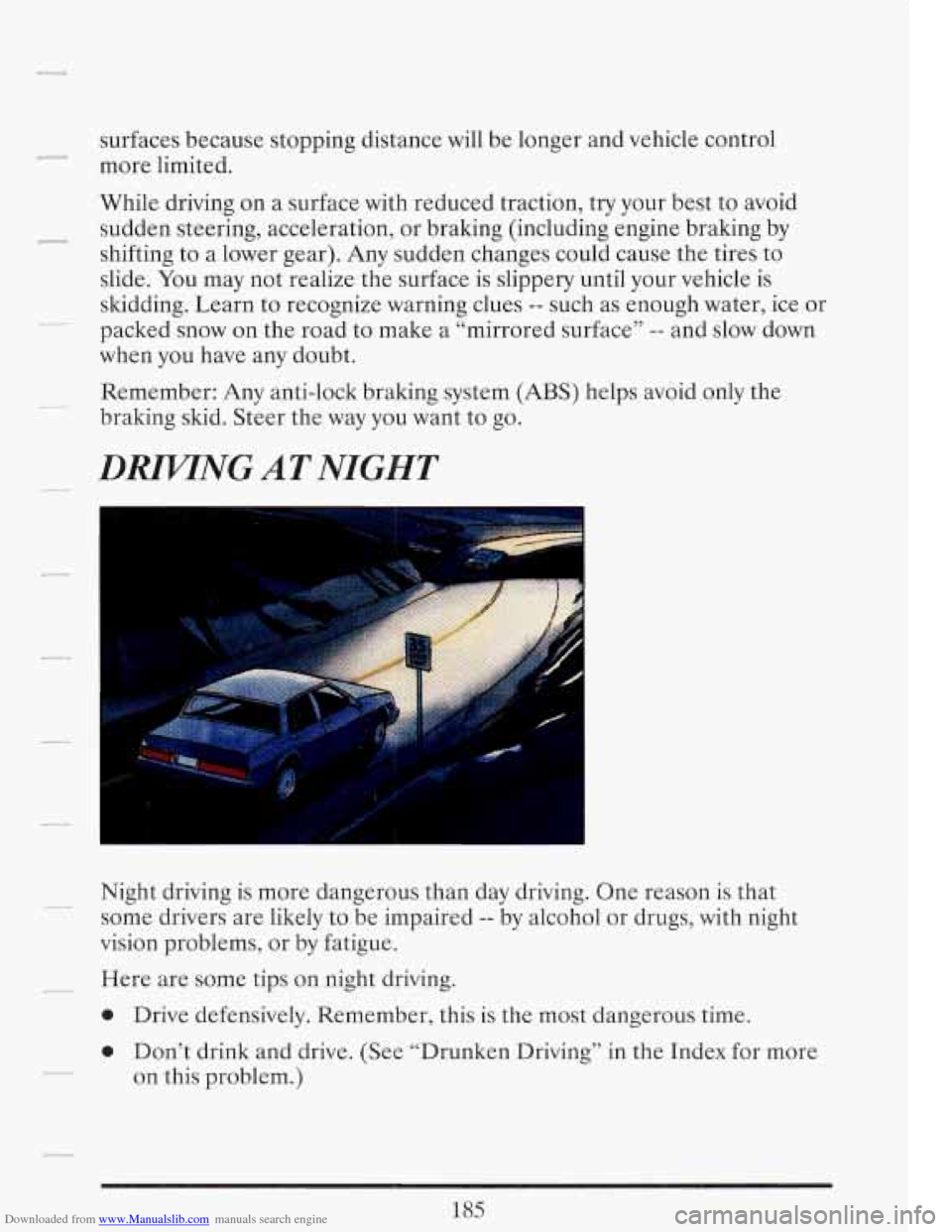
Downloaded from www.Manualslib.com manuals search engine surfaces because stopping distance will be longer and vehicle control
more limited.
While driving on a surface with reduced traction, try your best to avoid
sudden steering, acceleration, or braking (including engine braking by
shifting to a lower gear). Any sudden changes could cause the tires to
slide.
You may not realize the surface is slippery until your vehicle is
skidding. Learn to recognize warning clues
-- such as enough water, ice or
packed snow on the road to make a “mirrored surface”
-- and slow down
when you have any doubt.
Remember: Any anti-lock braking system
(ABS) helps avoid only the
braking skid. Steer the way you want to go.
DRMNG AT NIGHT
Night driving is more dangerous than day driving. One reason is that
some drivers are likely to be impaired
-- by alcohol or drugs, with night
vision problems, or by fatigue. --
I_ Here are some tips on night driving.
0 Drive defensively. Remember, this is the most dangerous time.
0 Don’t drink and drive. (See “Drunken Driving” in the Index for more
on this problem.)
Page 220 of 386
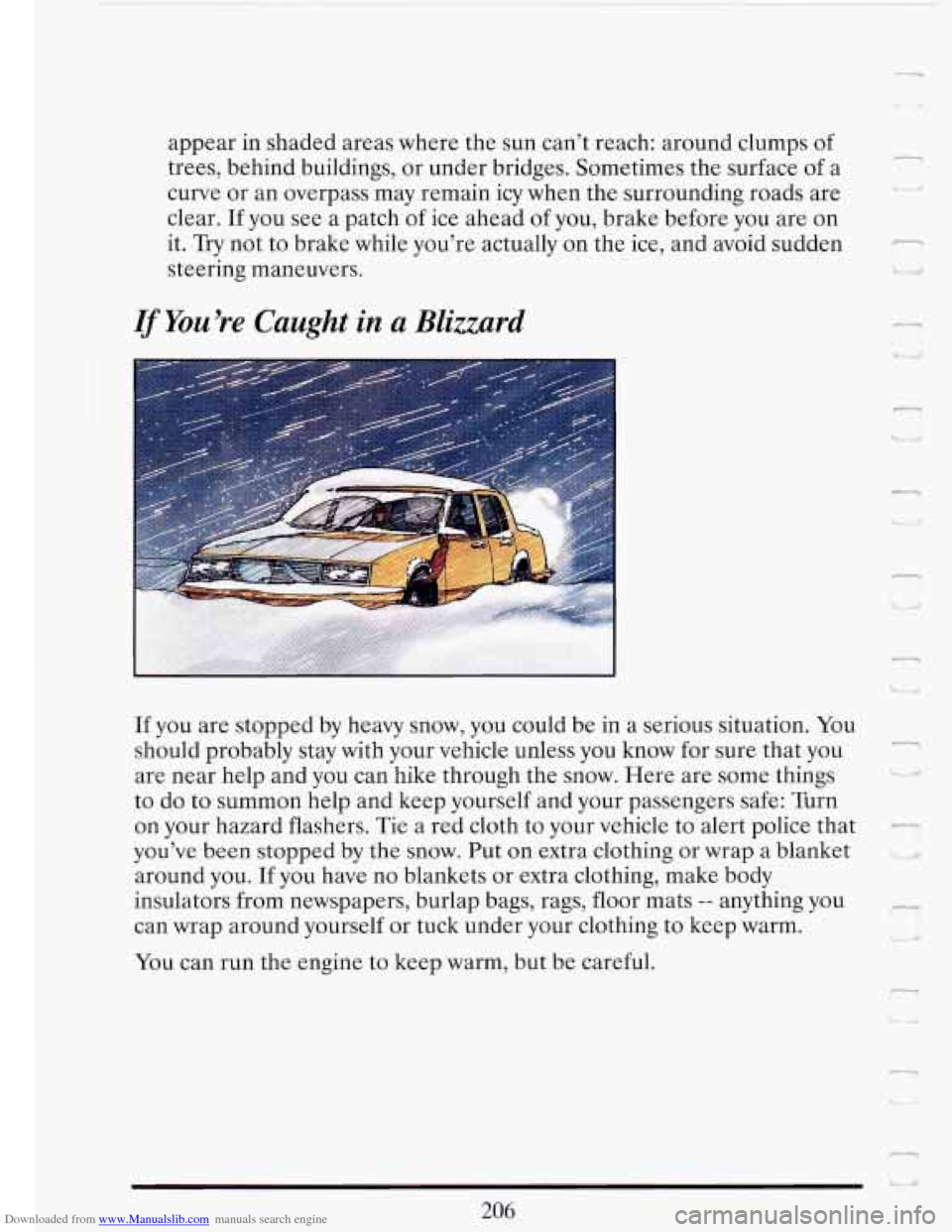
Downloaded from www.Manualslib.com manuals search engine x
appear in shaded areas where the sun can’t reach: around clumps of
trees, behind buildings, or under bridges. Sometimes the surface of a
curve or an overpass may remain icy when the surrounding roads are
clear. If you see a patch of ice ahead of you, brake before you are on
it.
Try not to brake while you’re actually on the ice, and avoid sudden
steering maneuvers.
If You’re Caught in a Blizzard
- I I1
3 I
R
If you are stopped by heavy snow, you could be in a serious situation. You
should probably stay with your vehicle unless you know for sure that you
are near help and you can hike through the snow. Here are some things
I
to do to summon help and keep yourself and your passengers safe: Turn
on your hazard flashers.
Tie a red cloth to your vehicle to alert police that -
you’ve been stopped by the snow. Put on extra clothing or wrap a blanket
around you. If you have no blankets or extra clothing, make body
insulators from newspapers, burlap bags, rags, floor mats
-- anything you
can wrap around yourself or tuck under your clothing to keep warm.
-
You can run the engine to keep warm, but be careful.
206
Page 227 of 386
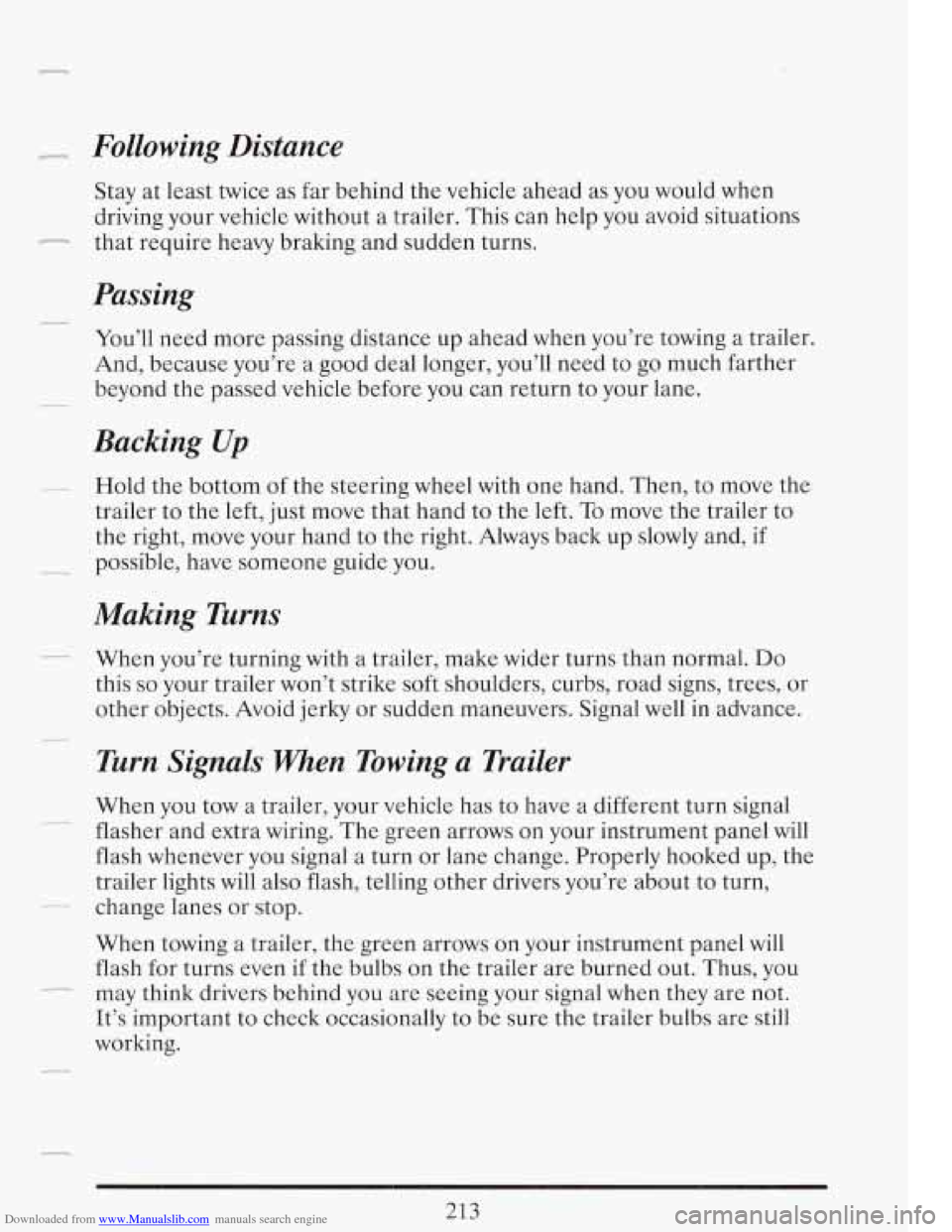
Downloaded from www.Manualslib.com manuals search engine - Following Distance
Stay at least twice as far behind the vehicle ahead as you would when
driving your vehicle without a trailer. This can help you avoid situations
- that require heavy braking and sudden turns.
Passing
I_
You’ll need more passing distance up ahead when you’re towing a trailer.
And, because you’re a good deal longer, you’ll need to go much farther
beyond the passed vehicle before you can return to your lane.
-
Backing Up
_- Hold the bottom of the steering wheel with one hand. Then, to move the
trailer to the left, just move that hand to the left.
To move the trailer to
the right, move your hand
to the right. Always back up slowly and, if
- possible, have someone guide you.
Making Turns
When you’re turning with a trailer, make wider turns than normal. Do
this so your trailer won’t strike soft shoulders, curbs, road signs, trees, or
other objects. Avoid jerky or sudden maneuvers. Signal well in advance.
1urn Signals When Towing a Trailer
When you tow a trailer, your vehicle has to have a different turn signal
flasher and extra wiring. The green arrows on your instrument panel will
flash whenever you signal a turn or lane change. Properly hooked up, the
trailer lights will also flash, telling other drivers you’re about to turn, -
- change lanes or stop.
213
When towing a trailer, the green arrows on your instrument panel will
flash for turns even
if the bulbs on the trailer are burned out. Thus, you
may think drivers behind you are seeing your signal when they are not.
It’s important to check occasionally to be sure the trailer bulbs are still
working. p__-_.
Page 238 of 386
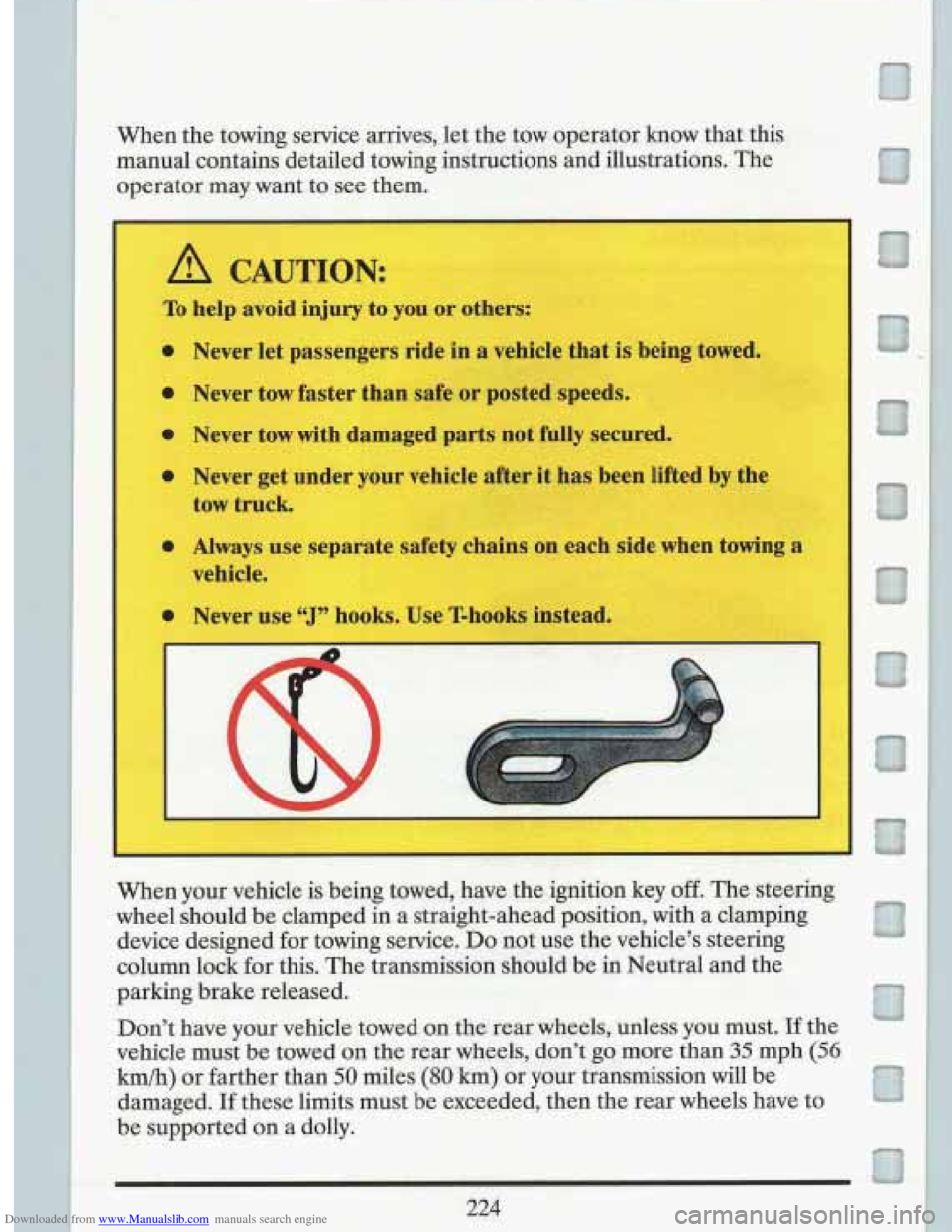
Downloaded from www.Manualslib.com manuals search engine When the towing service arrives, let the tow operator know that this
manual contains detailed towing instructions and illustrations. The
operator may want to
see them.
I
.. .
When your vehicle is being towed, have the ignition key off. The steering
wheel should be clamped in a straight-ahead position, with a clamping
device designed for towing service.
Do not use the vehicle's steering
column lock for this. The transmission should be in Neutral and the
parking brake released.
Don't have your vehicle towed on the rear wheels, unless you must.
If the
vehicle must be towed on the rear wheels, don't go more than
35 mph (56
krn/h) or farther than 50 miles (80 km) or your transmission will be
damaged. If these limits must be exceeded, then the rear wheels have to
be supported on a dolly.
224
Page 251 of 386

Downloaded from www.Manualslib.com manuals search engine 8. Then replace the
pressure cap. Be
sure the arrows on
the pressure cap
line up like this.
IF A TIRE GOES FLAT
-- It’s unusual for a tire to “blow out” while you’re driving, especially if you
maintain your tires properly. If air goes out of a tire, it’s much more likely
to leak out slowly. But
if you should ever have a “blowout,” here are a
If a front tire fails, the flat tire will create a drag that pulls the vehicle
toward that side. Take your foot
off the accelerator pedal and grip the
to a stop well out of the traffic lane.
A rear blowout, particularly on a curve, acts much like a skid and may
remove your foot from the accelerator pedal. Get the vehicle under
control by steering the way you want the vehicle to go. It may be
very
the road if possible.
__ few tips about what to expect and what to do:
__ steering wheel firmly. Steer to maintain lane position, then gently brake
__ require the same correction you’d use in a skid. In any rear blowout,
__ bumpy and noisy, but you can still steer. Gently brake to a stop, well off
If your tire goes flat, the next section shows how to use your jacking
--- equipment to change a flat tire safely.
CHMGING A FLAT TIRE
._- If a tire goes flat, avoid further tire and wheel damage by driving slowly to
a
level place. Turn on your hazard warning flashers.
237